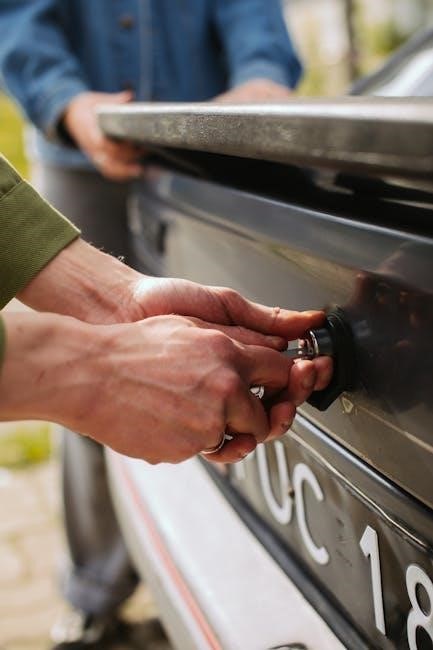
Welcome to the DWE7491 manual, your comprehensive guide to understanding and operating the DeWalt 10″ job site table saw. This section introduces key features, safety tips, and operational insights to ensure optimal performance and safety while using the saw. By following this manual, you’ll gain the knowledge needed to maximize the tool’s potential and maintain its longevity. Always refer to this guide for detailed instructions and troubleshooting assistance.
1.1 Overview of the DWE7491 Table Saw
The DeWalt DWE7491 is a heavy-duty 10″ job site table saw designed for professional-grade cutting tasks. It features a robust 254mm (10″) blade, capable of handling various materials with precision. The saw is built for durability and portability, making it ideal for job sites. With a rip capacity of up to 610mm, it excels in ripping large panels and timber. Its compact design and lightweight construction ensure easy transportation and setup. The DWE7491 includes a reliable fence system for accurate cuts and adust collection port for cleaner operations. This saw is perfect for carpenters, contractors, and woodworking enthusiasts seeking a powerful, versatile, and user-friendly tool for demanding projects.

1.2 Importance of Reading the Manual
Reading the DWE7491 manual is essential for safe and effective operation of the table saw. It provides detailed instructions for assembly, usage, and maintenance, ensuring you understand the tool’s capabilities and limitations. The manual highlights critical safety precautions to prevent accidents and damage to the equipment. By following the guidelines, you can optimize performance, avoid common errors, and extend the tool’s lifespan. Additionally, the manual includes troubleshooting tips and maintenance schedules, helping you resolve issues quickly and keep the saw in peak condition. Familiarizing yourself with the manual is a crucial step in mastering the DWE7491 and achieving professional-grade results in your woodworking projects.

Safety Precautions
Always wear protective gear, avoid loose clothing, and ensure proper blade guards are in place. Follow safety guidelines to prevent accidents and ensure safe operation of the DWE7491.
2.1 General Safety Guidelines
Always wear safety glasses, a dust mask, and hearing protection when operating the DWE7491. Ensure loose clothing and jewelry are secured to avoid entanglement. Keep the work area clean and well-lit to prevent accidents. Never operate the saw near flammable materials or in explosive environments. Maintain a firm grip on materials and avoid overreaching. Keep children and bystanders away from the work area. Ensure the blade guard is properly installed and functioning. Avoid using damaged or dull blades, as they can cause kickback. Follow all safety instructions provided in the manual to ensure safe and effective operation of the DWE7491 table saw.
2.2 Specific Safety Precautions for the DWE7491
Specific to the DWE7491, always use a push stick or other safety devices when making narrow rip cuts. Never perform ripping operations without the rip fence properly aligned. Ensure the riving knife is adjusted correctly to prevent kickback. Avoid cutting materials with nails or staples unless using a specialized blade. Keep the saw blade sharp and free from damage to maintain control. Always disconnect the power source before making adjustments or performing maintenance. Follow the manual’s guidelines for proper blade installation and alignment. Never leave the saw unattended while it is in operation. Adhere to these precautions to minimize risks and ensure safe operation of the DWE7491 table saw.

Assembly Instructions
Begin by unpacking and preparing the DWE7491 saw. Assemble the rip fence by aligning it with the miter slot and locking it securely. Ensure all components are tightened properly. Refer to the manual for specific alignment and installation steps. Use the provided tools to complete the assembly accurately. Always follow the instructions for proper installation to ensure the saw operates safely and efficiently.
3.1 Assembling the Rip Fence
Assembling the rip fence on your DWE7491 table saw is a straightforward process. Begin by unpacking the fence and aligning it with the miter slot on the saw’s table. Ensure the fence is properly seated and aligned with the guide rails. Secure the fence using the locking mechanism provided, making sure it is tightly fastened to ensure stability. Adjust the fence to your desired position and verify its accuracy using a measuring tape or caliper. Tighten all screws firmly to prevent any movement during operation. Always refer to the manual for specific alignment instructions to ensure precise cuts. Proper assembly of the rip fence is crucial for accurate and safe cutting operations. Use the provided tools for assembly to avoid damaging the components.
3.2 Other Assembly Requirements
Beyond the rip fence, the DWE7491 requires several additional components to be assembled for optimal functionality. Begin by attaching the miter gauge to the table saw, ensuring it aligns smoothly with the miter slot. Next, install the blade guard and anti-kickback pawls, which are essential for safety. Secure the fence rails to the saw table using the provided bolts, tightening them evenly to maintain alignment. If equipped, attach the auxiliary fence to the rip fence for narrower cuts. Finally, ensure all handles and knobs are securely fastened. Refer to the manual for specific torque values to avoid over-tightening. Proper assembly of these components ensures accurate cuts, safety, and longevity of the tool. Always double-check the alignment and tightness of all parts before operation.

Operational Instructions
Mastering the DWE7491 involves understanding its operational procedures. Always ensure the rip fence is properly aligned and the miter gauge is securely locked. Maintain a clean work area to prevent debris interference. Regularly inspect the blade for sharpness and alignment. Use push sticks or feather boards for safer narrow rip cuts. Keep loose clothing and long hair tied back. Ensure the workpiece is properly supported throughout the cut. Familiarize yourself with the emergency stop feature. Follow the manual’s guidelines for optimal performance and safety. Proper operation enhances accuracy, productivity, and tool longevity.
4.1 Starting the Saw
Before starting the DWE7491, ensure the work area is clear of debris and obstructions. Always wear safety glasses and keep loose clothing tied back. Check the power cord for damage and ensure it is connected to a suitable power source. Locate the power switch, typically found on the front or side of the saw. Press the switch firmly to engage the motor. Allow the blade to reach full speed before making any cuts. Never start the saw with the blade in contact with material. If the saw is new or has been serviced, run it without a load for a few minutes to ensure proper function. Refer to the manual for specific start-up procedures and safety guidelines to avoid accidents and ensure smooth operation. Proper starting techniques are essential for safe and effective use of the DWE7491.
4.2 Performing Basic Cutting Operations
To perform basic cutting operations with the DWE7491, align the material with the blade, ensuring it is flat and secure. Use the rip fence to guide straight cuts, adjusting it to the desired width. Always maintain a firm grip on the material, keeping your hands away from the blade. Use a push stick or other safety accessories for smaller or narrow cuts to avoid injury. Apply steady, consistent pressure, allowing the saw to do the work without forcing the material. Keep the workpiece flat on the table to prevent kickback. After completing the cut, turn off the saw and allow the blade to stop completely before leaving the machine. Proper technique ensures accurate cuts and safety while operating the DWE7491. Always refer to the manual for specific guidelines on various cutting operations.

Features of the DWE7491
The DWE7491 features a powerful 10″ blade, durable construction, and advanced rip fence for precise cuts. It includes a rolling stand for portability and a dust collection system for clean operation. The tool offers adjustable settings for various materials and applications, ensuring versatility and efficiency in woodworking projects.
5.1 Key Components and Specifications
The DWE7491 features a 10″ (254 mm) blade with a 5/8″ arbor size, delivering precise cuts for various materials. It includes a rolling stand for easy mobility and a dust port for efficient debris collection. The saw boasts a 15-amp motor, operating at 4,800 RPM for consistent performance. Key components include a telescoping fence system for accurate ripping and a 21.25″ x 13.75″ table size. The tool weighs 90 lbs, combining durability with portability. Specifications highlight a 3,650 RPM arbor speed and a 32.5″ rip capacity, ideal for large projects. The DWE7491 also offers a 45° bevel angle range and a 3-1/8″ maximum cut depth at 90°, ensuring versatility for diverse woodworking tasks. Its heavy-duty steel roll cage enhances durability, making it suitable for job site demands.
5.2 Advanced Features and Capabilities
The DWE7491 boasts a range of advanced features designed to enhance precision and versatility. Its Rack and Pinion fence system ensures smooth, accurate adjustments, while the 2-speed gearbox allows for optimized performance in various materials. The saw also features a 32.5″ rip capacity, enabling handling of larger stock. Additionally, it includes a 3-1/8″ maximum cut depth at 90°, ideal for deep cuts. The onboard storage system keeps accessories organized, and the durable steel roll cage provides long-lasting protection. These advanced capabilities make the DWE7491 a powerful tool for professionals and serious DIYers, delivering consistent results across a wide range of applications.

Maintenance and Care
Regular maintenance ensures optimal performance of the DWE7491. Clean the saw and components, lubricate moving parts, and inspect accessories. Replace worn or damaged parts promptly to maintain accuracy and safety.
6.1 Regular Maintenance Tasks

Regular maintenance is crucial to ensure the DWE7491 operates efficiently and safely. Start by cleaning the saw, removing dust and debris from the table, motor, and fence. Check the blade alignment and ensure the rip fence is parallel to the blade. Inspect the blade for wear or damage and replace it if necessary. Lubricate moving parts, such as the fence rails, to maintain smooth operation. Always refer to the manual for specific lubrication recommendations. Additionally, inspect the power cord and plug for damage. Store the saw in a dry, clean environment to prevent rust and corrosion. Regularly check and tighten all bolts and screws to ensure stability and accuracy. Proper maintenance extends the tool’s life and ensures consistent performance. Follow these tasks to keep your DWE7491 in optimal condition.
6.2 Tips for Extending Tool Life
To extend the life of your DWE7491, proper care and usage are essential. Regularly lubricate moving parts, such as the fence rails, to reduce friction and wear. Avoid exposing the saw to excessive moisture, as this can lead to rust and corrosion. Store the tool in a clean, dry environment when not in use. Always use the correct blade for the task to prevent overheating and blade damage. Keep the saw table and components free from dust and debris to ensure smooth operation. Follow the manual’s guidelines for load capacity and operating conditions to avoid overloading the motor. By adhering to these tips, you can maximize the longevity and performance of your DWE7491 table saw.

Troubleshooting Common Issues
This section addresses frequent problems encountered with the DWE7491, such as uneven cuts, motor overload, or fence misalignment. Follow diagnostic steps and solutions to resolve issues efficiently.
7.1 Diagnosing Common Problems
Identifying issues with the DWE7491 begins with understanding common symptoms. Uneven cuts may stem from a misaligned rip fence or dull blade. Motor overload could indicate excessive material thickness or improper blade use. Fence misalignment can cause inaccurate measurements, while blade wobble suggests improper installation or wear. Strange noises may point to loose parts or debris. Always refer to the manual for diagnostic steps and solutions. Regularly inspect the blade, fence, and motor for optimal performance. Use the included push stick and auxiliary fence for safer operations. Addressing these issues promptly ensures reliable results and extends the tool’s lifespan.
7.2 Solutions to Frequently Encountered Issues
Common issues with the DWE7491 can often be resolved with simple adjustments. For uneven cuts, ensure the blade is properly aligned and sharp. If the motor overloads, check for excessive material thickness or incorrect blade usage. Misaligned fences can be recalibrated by following the manual’s instructions. Blade wobble may require tightening the arbor bolt or replacing worn components. Strange noises could indicate loose parts or debris buildup, which can be addressed by cleaning and securing all components. Always refer to the manual for specific troubleshooting steps. Regular maintenance, such as lubricating moving parts and ensuring proper fence alignment, can prevent many issues. Addressing problems promptly ensures smooth operation and extends the tool’s lifespan.

Accessories and Attachments
Explore essential accessories like push sticks, rip fences, and feather boards to enhance your DWE7491’s functionality. These attachments improve safety, precision, and versatility for various cutting tasks. Always refer to the manual for compatibility and installation guidance to maximize your saw’s performance and adaptability.
8.1 Recommended Accessories
The DWE7491 manual highlights several recommended accessories to enhance your table saw’s functionality. A push stick is essential for safely guiding materials during ripping operations. Additionally, a narrow rip auxiliary fence and feather boards are suggested to improve cutting accuracy and prevent kickback. These accessories not only enhance performance but also contribute to a safer working environment. For optimal results, ensure all attachments are compatible with your DWE7491 model. The manual provides detailed instructions on how to install and use these accessories effectively. Always prioritize genuine DeWalt parts or approved alternatives to maintain tool performance and safety standards. By incorporating these recommended accessories, you can maximize the versatility and efficiency of your table saw for various woodworking projects.
8.2 Using Attachments for Enhanced Functionality
Using attachments with the DWE7491 can significantly enhance its functionality and versatility. The manual recommends utilizing a push block and feather boards to improve control during cutting operations, reducing the risk of kickback. Additionally, a narrow rip auxiliary fence is ideal for making precise cuts in narrower materials. These attachments not only improve accuracy but also contribute to safer operating conditions. For optimal performance, ensure all attachments are correctly installed and aligned according to the manual’s instructions. Proper use of these accessories can expand the range of tasks your table saw can handle, making it a more valuable tool for various woodworking projects. Always refer to the manual for specific guidance on attachment installation and usage.




